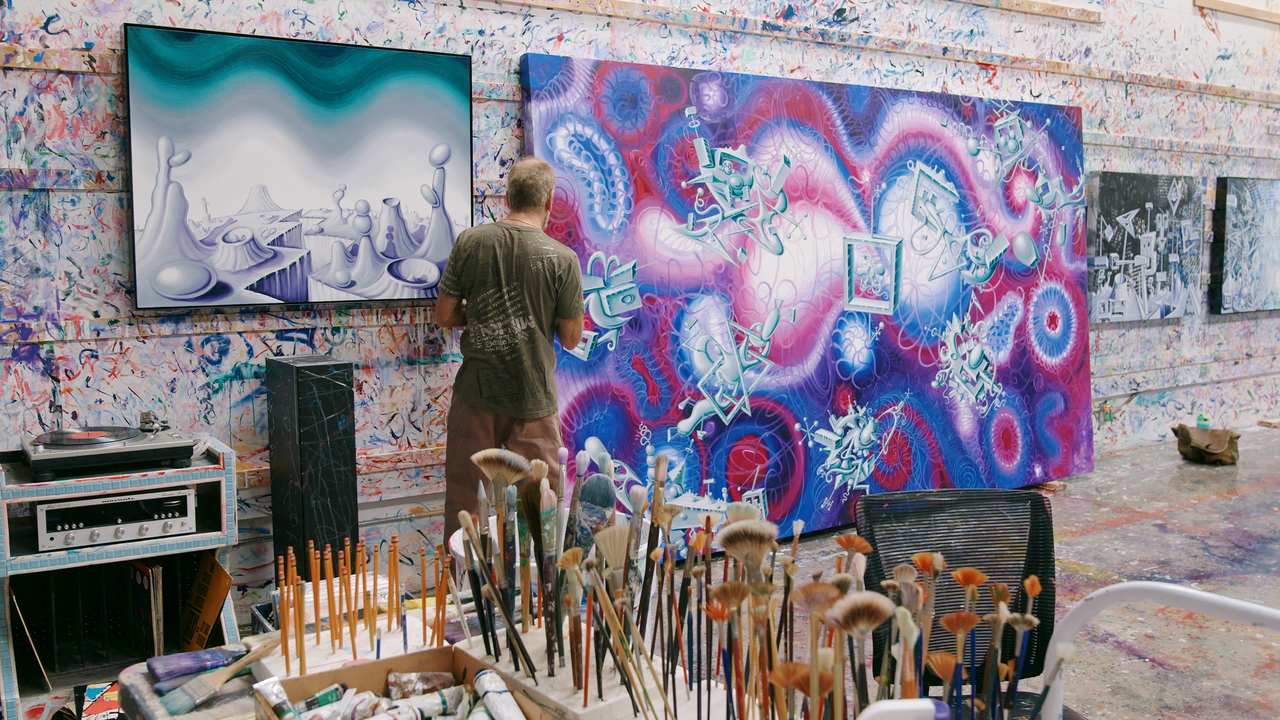Celestial Bodies
Verne Dawson
Verne Dawson

Verne Dawson is a thinking person's painter. His work grapples with grand ideas often considered quaint in contemporary art circles. Mortality, humankind's place in the universe, the spiritual aspect of nature, the mythological underpinnings of civilization and the search for meaning are all accorded great consideration. What other artist in the 21st century would, with a straight face, make a big, circular painting of The Celestial Atlas (2002)? While every artist has their field of endeavour, Dawson's arena is the cosmos and his art desires to encompass everything. Combined with an obvious passion for tradition, this desire manifests itself in a plethora of genres. Still lifes, portraits, landscapes, allegorical scenes, various abstract compositions including colour field and stripe painting, historical subjects, fantasy and science fiction imagery, nudes, pets and architectural motifs all figure in his work.
Frequently described in terms reserved for Folk or Outsider Art, Dawson's paintings look homey, childlike and just plain dumb. They are rough, unsophisticated and, by most criteria associated with contemporary painting, unskilled. Goofy in their earnestness and endearing in their lack of guile, they charm more than impress. The black outlines and heavy brushwork of pictures such as Self-Portrait (2001) and Study (Nude, after Watteau) (2001) recall Max Beckmann, while the populated scenes owe something to Hieronymous Bosch. Yet for Dawson issues of painting are secondary to the struggle to come to terms with something larger than himself, something beyond reason. The very act of putting brush to canvas is fraught with questions, conflict, doubt. Yearning for meaning without the hope of finding any, his work eschews Joycean epiphanies. There's little resolution here. In its place, however, is a reckoning: a reckoning with the impossibility of knowledge and the beautiful melancholy of nothing less than human existence.
Let them work a while and eventually Dawson's pictures gnaw at you. Their refusal to coalesce, to look smart, to get it right, is vexing. But the problem with getting it right is that Dawson's understanding of what this means is constantly in flux, pushed hither and thither by a restless intellect and a passion forever unfulfilled. Careworn, the paintings have the quality of palimpsests. They are ruins before they are finished. Returning much later, Dawson won't hesitate to tear into a canvas all over again, as in Virgin (1986-2001), which he felt compelled to mess with after a span of 15 years. This takes courage, but Dawson's work is nothing if not brave; it withholds nothing, risks everything and generally fails. But it is the failure of impossible ambitions, the type of failure Oscar Wilde called 'exquisite'.
In the vocabulary of Dawson's painting we find its most significant, potent and rewarding implications. The comparisons to Outsider Art, while fruitful, are also misleading. Although his work shares the obsessive characteristics, mythological fixations and desublimated qualities of much of the work of psychiatric patients, it is not psychotic. (One may recall Salvador Dalí's famous quip that the only difference between himself and a madman was that he was not mad.) Occasionally cryptic, Dawson's concerns are not subsumed by symbolic or arcane systems (an exception being his gridded colour field abstractions based on ancient calendars). Nor do they lapse into aphasia universalis, the complete loss of language experienced by many schizophrenics. Jean Dubuffet, in coining the term Art Brut, described it as 'art that forgets its very name', but Dawson's work is an art of remembrance in a manner not dissimilar to that of Luc Tuymans. Nor does Dawson seek to fill the horror vacuithat motivates many of the most renowned Outsider artists. While Adolf Wolfli, Johann Knupfer and J. B. Murry flooded the space of their drawings and paintings with visual glossolalia - scribbles, patterns and text - Dawson's compositions are often spacious. In his landscapes, such as Manhattan (1998) and Cycle of Quarter-Day Observances, circa 23,800 BC (2000), an expanse of blue sky dominates the upper two-thirds of the image. Unafraid of emptiness, humans in these pictures are almost always tiny, cast against an imposing combination of nature and the void.
Conversely, Dawson finds no purpose in faux-Primitive or tribal mark-making. He does not idealize cave painting; rather, his fascination with the past is simultaneously anthropological and mystical: he looks back to our human origins for insight into the present and the possible direction of the future.
If Dawson's practice falls outside the vocabulary of both Outsider Art and modern Primitivism, it also has little in common with the language of contemporary painting. There is a noteworthy lack of irony, pastiche and appropriation. In fact, it seems to me that, following Deleuze and Guattari's study of the writing of Franz Kafka, Dawson's visual language might best be characterized as 'minor'. This is not to say that his work lacks ambition or high-mindedness but, rather, that the language in which he couches his themes is purposefully low-key - unique but not unrecognizable, subversive but not rebellious. Which is not to say that considering Dawson's painting as minor marginalizes it. While the issue of language is of concern to individuals and groups occupying the margins, whether by choice or by social mechanisms of exclusion, their strategy of resistance often involves the outright rejection of major language in favour of an alternative tongue. Operating firmly within the territory of our cultural majority - attending art school, exhibiting in art galleries and museums - Dawson's speech, while halting, stuttering, strangled, is never impolite or improper. It does not call attention to its rebellious nature but gently goes its own way, quietly disobeys. Deleuze and Guattari describe Kafka as 'finding his own point of underdevelopment', 1 but this could very well describe Dawson's trajectory of over the last 20 years. His work has not so much progressed as remained entrenched in its digressive tendencies. As Kafka was a stranger within his own language, within literature, so Dawson is a stranger within painting. He is without peers, an exile. And just as Kafka saw in America both the promise and nightmare of the future, so Dawson is also distinctly American. Valuing the roots of US democracy while disavowing what he sees as the current betrayal of those roots, Dawson has followed the tradition of conscientious objectors and become an expatriate, recently moving from New York to Paris.
Part of the function of minor forms is to deterritorialize. Thus it should be no surprise that much of Dawson's work is concerned with the land and questions about how we ground ourselves in a world increasingly indeterminate. His paintings have been described as depicting a fantasy Arcadia and there are certainly a fair share of flower children, blonde virgins, bearded gurus and pendulous-breasted Earth Mothers cavorting in canvases such as Cycle of Quarter-Day Observances, circa 23,800 BC: Study for Summer (2000), Bathers (2002) and Rainbow Gathering (1998). Yet this Utopia is tempered by an underlying appreciation of the darker forces in both Man and Nature. When Dawson paints The Future (1998), he shows us the sun sinking over a city in ruins; in Untitled (1996) it is a forbidding Corbusian apartment block. Similarly, in his view the past is not necessarily simpler or more harmonious. Rituals, he knows, are often disturbing and violent. Thus, in 23,800 BC, When Santa was a Shaman (2000) the cheery symbol of Christmas generosity is returned to his primal origins. Angrily dancing on a hillside like some vengeful pagan god, Santa sports antlers on his head and clutches a flaming branch in his raised fist. Giving, Dawson implies, is not nearly enough. What is needed is sacrifice.
The product of an acute social conscience, Dawson's painting is always political. If, according to Deleuze and Guattari, in minor literature there are 'no possibilities for an individual enunciation that [...] could be separated from a collective enunciation', then Dawson's work is the very embodiment of all that is minor. 2 For him individual concerns are always tied to the greater concerns of society, nature and the cosmos. Humble and self-effacing, Dawson rarely talks of himself. His art tries to speak for us all.
1. G. Deleuze and F. Guattari, Kafka: Toward a Minor Literature, trans. D. Polan, University of Minnesota Press, Minneapolis, 1986, p. 18.
2. Ibid. p. 17.














